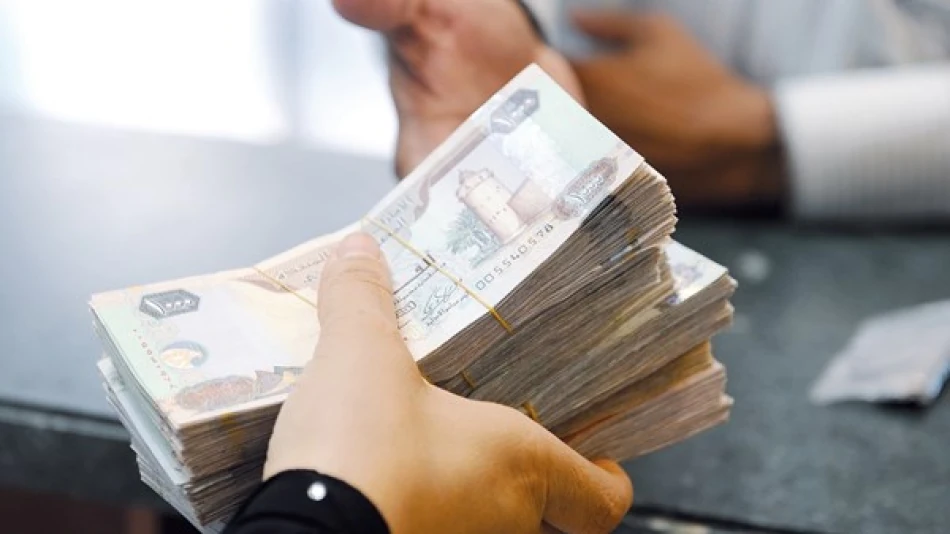
The UAE Banking Sector's Assets Reach AED 4.75 Trillion in April
UAE Banking Sector Shows Resilience as Assets Hit AED 4.75 Trillion
The UAE's banking sector demonstrated steady growth in April 2025, with total banking assets reaching AED 4.749 trillion, marking a 0.6% monthly increase. This expansion, driven by robust credit growth and a significant surge in non-resident deposits, underscores the Emirates' position as a regional financial hub attracting international capital amid global economic uncertainty.
Credit Growth Accelerates Across Multiple Sectors
Total credit extended by UAE banks rose 0.9% month-on-month to AED 2.259 trillion in April, according to Central Bank data. This growth was fueled by a AED 12.3 billion increase in domestic credit and AED 7.1 billion rise in foreign credit, indicating healthy lending appetite across both local and international markets.
The domestic credit expansion was broad-based, with government sector credit rising 0.7%, government-related entities seeing 1.2% growth, and private sector lending increasing 0.6%. However, credit to non-banking financial institutions contracted 4.3%, possibly reflecting regulatory tightening or reduced demand from these entities.
What This Means for Investors
The diversified credit growth suggests UAE banks are successfully managing risk while supporting economic expansion. Private sector lending growth, though modest, indicates continued business confidence and investment activity. The decline in lending to non-banking financial institutions may signal banks' preference for direct exposure to end borrowers rather than intermediaries.
Non-Resident Deposits Surge as UAE Attracts Global Capital
Perhaps the most striking development was the 10.9% monthly surge in non-resident deposits to AED 275.6 billion, while resident deposits grew a modest 0.1% to AED 2.689 trillion. This dramatic inflow of foreign funds reflects the UAE's growing appeal as a safe haven for international wealth.
Within resident deposits, both government (0.9%) and private sector (1.1%) deposits increased, while non-banking financial institutions saw deposits fall 9.2% and government-related entities declined 6.5%.
Regional Context and Implications
The UAE's ability to attract non-resident deposits mirrors similar trends seen in Singapore and Switzerland, where political stability and favorable regulations draw international capital. This influx provides UAE banks with a growing funding base for expansion, but also increases their exposure to volatile international flows.
Mixed Signals in Money Supply Indicators
The Central Bank's money supply data revealed divergent trends across different measures. M1 money supply jumped 2.6% to AED 1.01 trillion, driven by a AED 26.9 billion increase in demand deposits that offset a AED 1.2 billion decline in currency in circulation.
However, M2 money supply contracted slightly by 0.1% to AED 2.435 trillion due to a AED 27.8 billion decrease in quasi-monetary deposits. M3 expanded 0.2% to AED 2.898 trillion, supported by a AED 6.6 billion rise in government deposits.
Monetary Policy Implications
The mixed money supply signals suggest the Central Bank is maintaining a balanced approach to liquidity management. The M1 growth indicates healthy transaction demand, while the M2 contraction may reflect banks' efforts to optimize their funding costs in a rising rate environment.
Central Bank Balance Sheet Reflects Stability
The UAE Central Bank's foreign assets rose modestly to AED 937.5 billion, with the portfolio split between AED 403.2 billion in bank balances and deposits abroad, AED 490.1 billion in foreign securities, and AED 44.1 billion in other foreign assets.
The Central Bank's total balance sheet expanded to AED 972.3 billion, with current accounts and deposits representing the largest liability component at AED 449.1 billion, followed by monetary bills and Islamic certificates of deposit at AED 279.9 billion.
Outlook: Positioning for Continued Growth
The April data suggests the UAE banking sector is well-positioned for sustained expansion, supported by diversified funding sources and prudent risk management. The surge in non-resident deposits provides a competitive advantage, offering banks cheaper funding while reflecting international confidence in the UAE's economic model.
For market participants, the data indicates a banking sector that's successfully balancing growth with stability. The broad-based credit expansion and strong deposit inflows suggest UAE banks are likely to report solid earnings growth, making them attractive to investors seeking exposure to the Middle East's most diversified economy.
The challenge ahead will be managing the volatility that comes with increased reliance on international deposits while maintaining the credit discipline that has made UAE banks among the region's most resilient financial institutions.
Most Viewed News

 Layla Al Mansoori
Layla Al Mansoori






